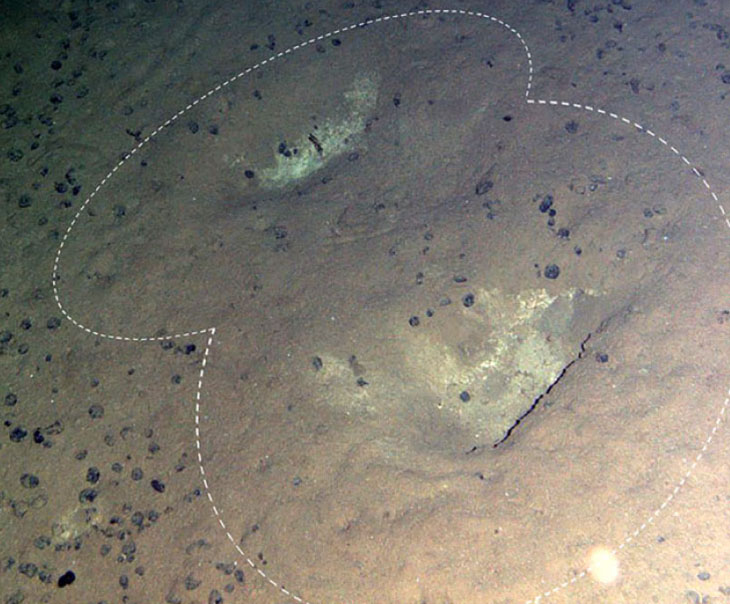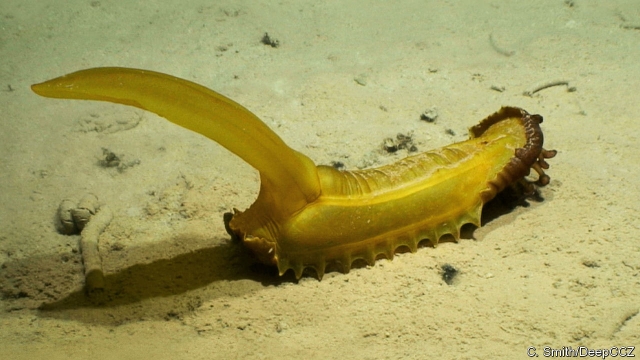A series of tantalizing tracks on the seafloor led Dr. Leigh Marsh on a journey of discovery that could have significant implications for our understanding of the ecology of nodule fields while extending the record for deep diving marine mammals by over 1000 meters.
It began in 2015, when the science team aboard the RRS James Cook observed strange depressions in the seafloor during baseline surveys of the Clarion-Clipperton Fracture Zone. Though often imperceptible on camera, these tracks were detected by the high-resolution side-scan SONAR system on the AUV Autosub6000. Too large to be attributed to local deep-sea fauna and too consistent to be the result of geologic processes, the tracks initially perplexed the researchers. This ultimately led to an unexpected conclusion, the tracks most resembled depressions made by beaked whales and other marine mammals in shallower ecosystems.
“This observation is one of very few that demonstrates the potential link between the deep-sea and air-breathing marine mammals that, for many species we believe, live most of their life elsewhere in the oceans.” Says Marsh, who also notes that the depth of some of these tracks would increase the observed maximum (though not the theoretical maximum) dive depth for beaked whales.
This finding could have a substantial impact on how future environmental impact assessments in the Area are conducted. Marine mammals are generally not covered in particular detail, with most surveys conducted non-systematically during transits based on bridge observations. In one EIA, Global Sea Mineral Resources notes that “No whales or larger sea mammals have been sighted in the Belgian Contract Area during any of the exploration cruises. Deployment of the AUV (autonomous deep multibeam system) a few tens of meters to a few meters above the seafloor has the advantage that it has no potential impacts on mammals, as these are not found at the abyssal depths of the contract area.”
According to Marsh, “the fact that they did not see any deep-diving whales is not surprising. Deep-diving whales (specifically beaked whales) are the most specialized and least understood of all marine mammals. They are inconspicuous and elusive deep-divers, surfacing only briefly to breathe – and when they do, they have a low-surface profile, which means traditional vessel-based methods may not suffice.”
“Just because deep-diving whales have not been observed in situ, does not mean they are not capable of diving to these depths–or utilizing the seafloor in the abyss. For me, this is the best part of ocean exploration. This discovery was the result of surveying the seafloor in a unique way and the observations were not part of the original science objectives. We did not go out to the CCZ with the intention of finding or mapping these scours. But now we know they exist, we have to think of innovative ways to use autonomous and robotic technology to detect, and potentially observe whales at depth which will complement both this new high-frequency sidescan, low altitude mapping data, and the important tagged data that exists for these species.”
Much like the discovery of octopus and skate nurseries at hydrothermal vents, these beaked whale tracks on the seafloor point to a more complex and interconnected relationship between mining sites, the larger deep ocean, and the surface.
“I don’t think we are anywhere near completing the environmental puzzle at the CCZ,” says Marsh. “The CCZ is so vast, and although we call the region where the nodules occur an abyssal plain, the topography varies dramatically and is in no-way uniform within each license area, let alone the region as a whole. These regions are largely unmapped (to sufficient resolution), and unexplored. Personally, I do not think we have enough data to adequately describe an environmental baseline at these sites. I am also concerned that each contractor appears to be conducting an EIA in isolation, and the cumulative impacts over the CCZ region have yet to be addressed.”





